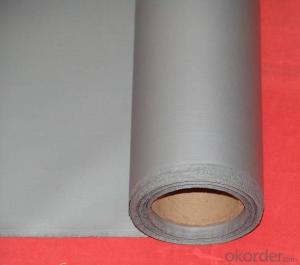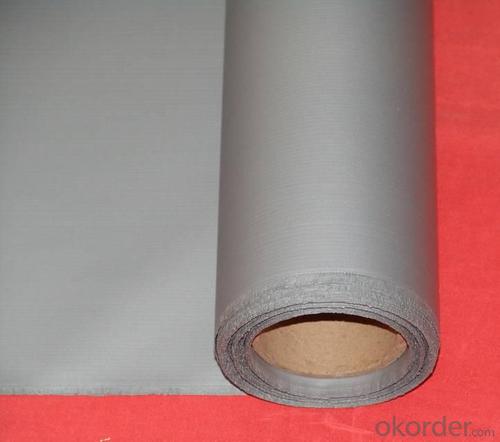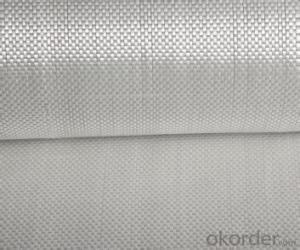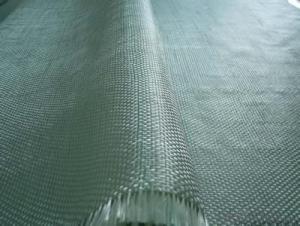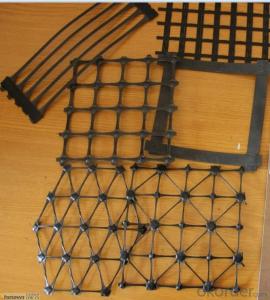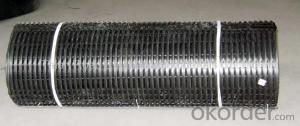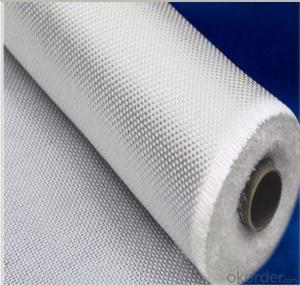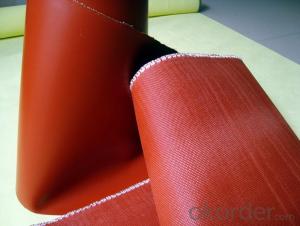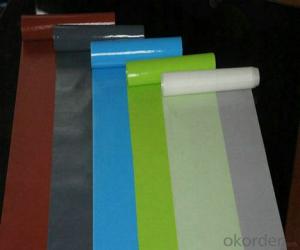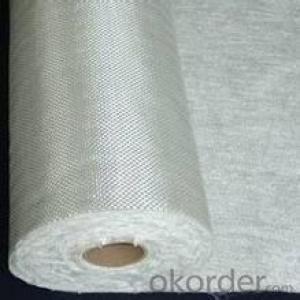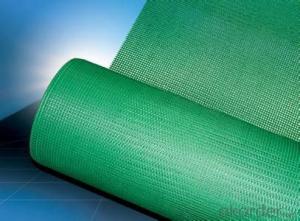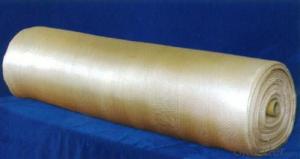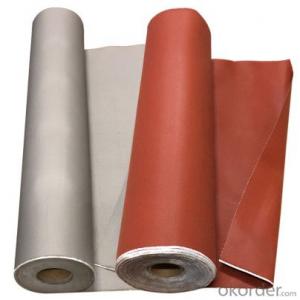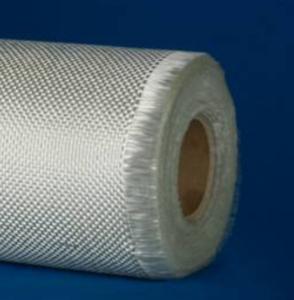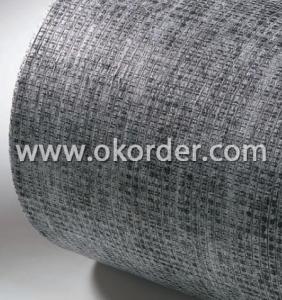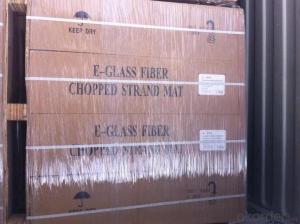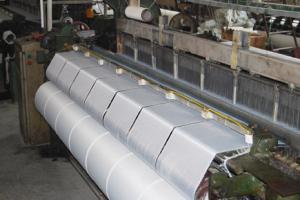Silicon Coated Fiberglass Fabric
- Loading Port:
- Shanghai
- Payment Terms:
- TT OR LC
- Min Order Qty:
- 10000 m²
- Supply Capability:
- 500000 m²/month
OKorder Service Pledge
OKorder Financial Service
You Might Also Like
high mechanical strength,good heat and color resistance,good sealing property,resistance to many common chemical
Properties:
1. Service Temperature -70~300
2. Ozone, oxide, light and weathering aging resistance, excellent weather ability used in outdoors and ages may be reached to 10 years.
3. High insulation: Dielectric constant from 3 to 3.2, breakdown voltage from 20 to 50KV/mm
4. Physical and chemical properties.
Application:
1) Electric insulation: Silicone rubber coated fiberglass cloth features high grade of electric insulation and bear a load of high voltage. It fits for making products like insulation cloth and sleeves
2) Non-metallic compensator: Used as pipeline flexible coupling, non-metallic compensator helps to avoid damage caused by heat expansion and cold contraction. This membrane material specially fit for use in industries of petroleum, chemical engineering, cement, iron and steel and energy sources due to its special features of temperature resistance, anti-corrosion, anti-aging, and good elasticity and toughness
3) Anti-corrosion sector: It is good to be used as inner and outer anti-corrosion layer featuring excellent corrosion resistance, temperature resistance and high strength. It proves to be an ideal anti-corrosion material
4) Others: Apart from above application, it can also be used as sealing material, temperature resistant and anti-corrosion conveyer belt, as well as packaging material.
| model | Thickness(mm) | Thickness(mil) | Breaking Strength(n/50mm) | Bursting Strength | Combustible | width |
| KQ-10 | 0.15 | 6 | 1500/1200 | 2.0 | ≤ 25% | 0-1500mm |
| KQ-20 | 0.25 | 10 | 1800/1500 | 2.1 | ≤ 25% | 0_ 1500mm |
| KQ-30 | 0.40 | 16 | 2000/1600 | 2.2 | ≤ 25% | 0_ 1500mm |
| KQ-40 | 0.50 | 20 | 2200/1800 | 2.3 | ≤ 25% | 0_ 3000mm |
| KQ-50 | 0.60 | 24 | 2400/2200 | 2.4 | ≤ 25% | 0_ 3000mm |
| KQ-60 | 0.70 | 28 | 2500/2300 | 2.4 | ≤ 25% | 0_ 3000mm |
| KQ-70 | 0.80 | 31 | 2600/2400 | 2.5 | ≤ 25% | 0_ 3000mm |
| KQ-80 | 0.90 | 35 | 2800/2600 | 2.5 | ≤ 25% | 0_ 3000mm |
| KQ-90 | 1.00 | 40 | 3000/2800 | 2.6 | ≤ 25% | 0_ 3000mm |
| KQ-11 | 1.20 | 47 | 3400/3000 | 2.5 | ≤ 25% | 0_ 3000mm |
| KQ-12 | 1.50 | 59 | 3700/3300 | 2.8 | ≤ 25% | 0_ 3000mm |
| KQ-13 | 2.00 | 79 | 4200/3800 | 3.5 | ≤ 25% | 0_ 3000mm |
| KQ-14 | 3.00 | 118 | 6500/6200 | 5.0 | ≤ 25% | 0_ 1000mm |
- Q: Can fiberglass fabric be used for reinforcement in pipes and tanks?
- Indeed, pipes and tanks can benefit from the reinforcement offered by fiberglass fabric. This material boasts exceptional strength and durability, along with its ability to resist corrosion, rendering it an optimal selection for reinforcing structures that might endure severe chemicals or extreme temperatures. The fabric can be affixed to either the inner or outer surface of the pipe or tank, delivering enhanced stability and strength. Furthermore, fiberglass fabric offers the advantage of being lightweight and flexible, enabling it to conform effortlessly to the shape of the pipes or tanks, guaranteeing a reliable and efficient reinforcement.
- Q: Can fiberglass fabric be used for making flags and banners?
- Yes, fiberglass fabric can be used for making flags and banners. It is a durable and lightweight material that can withstand outdoor conditions. It is also resistant to tearing and fading, making it a suitable choice for long-lasting flags and banners.
- Q: What are the different coating options available for fiberglass fabric?
- There are several coating options available for fiberglass fabric. These coatings are designed to enhance the fabric's properties and make it suitable for various applications. 1. Silicone Coating: Silicone coating provides excellent heat resistance and can withstand high temperatures. It also offers good chemical resistance, making it suitable for applications in industries such as aerospace, automotive, and insulation. 2. Polyurethane Coating: Polyurethane coating provides a durable and flexible finish to fiberglass fabric. It offers good abrasion resistance, waterproofing, and UV stability. This coating is commonly used in applications like outdoor covers, tents, and awnings. 3. PTFE Coating: PTFE (Polytetrafluoroethylene) coating is known for its non-stick properties and high resistance to chemicals, heat, and weathering. It provides excellent electrical insulation and low friction properties. PTFE coated fiberglass fabric is commonly used in applications such as conveyor belts, release sheets, and insulation. 4. Acrylic Coating: Acrylic coating provides a smooth finish and enhances the fabric's durability and strength. It offers good resistance to UV rays, mildew, and abrasion. This coating is commonly used in applications like marine covers, outdoor furniture, and bags. 5. Neoprene Coating: Neoprene coating provides excellent resistance to oil, chemicals, and weathering. It also offers good flame resistance and flexibility. This coating is commonly used in applications such as protective clothing, gloves, and industrial curtains. 6. Vinyl Coating: Vinyl coating provides a waterproof and durable finish to fiberglass fabric. It offers good resistance to UV rays, abrasion, and chemicals. This coating is commonly used in applications like outdoor furniture, truck covers, and pool liners. These are just a few examples of the different coating options available for fiberglass fabric. The choice of coating depends on the specific requirements of the application, such as heat resistance, chemical resistance, flexibility, and durability.
- Q: Can fiberglass fabric be used for making medical devices?
- Certain medical devices can indeed be made using fiberglass fabric. Fiberglass possesses numerous properties that render it appropriate for medical applications. Its lightweight nature, flexibility, and durability make it well-suited for manufacturing medical equipment such as braces, splints, casts, and prosthetics. The malleability of fiberglass fabric allows it to be molded into diverse shapes and sizes, enabling customization and ensuring a comfortable fit for patients. In the field of orthopedics, it is commonly employed to fashion supportive structures that aid in the healing process or provide immobilization. Fiberglass casts, for instance, are widely utilized for bone fractures due to their ability to provide indispensable support and protection while allowing ventilation. Moreover, fiberglass fabric is non-reactive and hypoallergenic, making it ideal for medical devices that come into direct contact with the skin. It can be easily sterilized, ensuring a hygienic environment for patients and mitigating the risk of infections. Nevertheless, it is crucial to acknowledge that not all medical devices can be fashioned using fiberglass fabric. Certain devices may necessitate specific materials that offer distinct properties or conform to particular regulatory standards. Consequently, the decision to employ fiberglass fabric in the production of medical devices should be based on the specific requirements of the device and in accordance with pertinent regulations and standards.
- Q: Is fiberglass fabric resistant to chemicals and solvents?
- Yes, fiberglass fabric is generally resistant to chemicals and solvents.
- Q: What are the temperature resistance capabilities of fiberglass fabric?
- Fiberglass fabric typically has high temperature resistance capabilities, with most varieties able to withstand temperatures up to 1,000 degrees Fahrenheit (538 degrees Celsius) or higher. However, the exact temperature resistance depends on the specific type and grade of fiberglass fabric being used.
- Q: Is fiberglass fabric suitable for outdoor use?
- Indeed, fiberglass fabric proves to be a viable option for outdoor utilization. Renowned for its exceptional sturdiness and ability to withstand diverse environmental influences, such as sunlight, moisture, and temperature fluctuations, fiberglass fabric is highly regarded. Moreover, it exhibits remarkable resistance to chemicals, rendering it appropriate for outdoor applications where exposure to severe weather conditions or chemicals is anticipated. In addition, fiberglass fabric boasts attributes such as lightweightness, flexibility, and ease of handling, making it an optimal selection for outdoor commodities, including awnings, canopies, boat covers, and upholstery for outdoor furniture. Its capacity to endure high temperatures and its property of being fire-retardant also contribute to its suitability for outdoor use. All in all, fiberglass fabric is a dependable and extensively utilized material for outdoor applications due to its robustness, durability, and resistance to various outdoor elements.
- Q: Is fiberglass fabric easy to cut and sew?
- Yes, fiberglass fabric is relatively easy to cut and sew. It can be cut using standard fabric scissors or a sharp utility knife. However, it is important to note that fiberglass fabric can be more difficult to cut than traditional fabric materials due to its strength and durability. It is recommended to use sharp tools and apply steady pressure to ensure clean cuts. When it comes to sewing, fiberglass fabric can be sewn using a regular sewing machine or by hand. It is recommended to use a heavy-duty needle and a strong, durable thread such as polyester or nylon. Additionally, it may be helpful to use a walking foot attachment on the sewing machine to handle the thickness and stiffness of the fabric. Overall, while fiberglass fabric may require slightly more effort and specialized tools compared to traditional fabrics, it is still possible to cut and sew it with relative ease. With proper tools, techniques, and precautions, you can successfully work with fiberglass fabric for various projects.
- Q: Can fiberglass fabric be used for reinforcement in bridge structures?
- Certainly, bridge structures can utilize fiberglass fabric for reinforcement. Fiberglass fabric, a robust and enduring material, possesses numerous advantages when employed in bridge construction. The primary benefit of incorporating fiberglass fabric for reinforcement in bridge structures lies in its exceptional strength-to-weight ratio. Renowned for its remarkable strength, fiberglass fabric is significantly lighter than conventional reinforcement materials like steel. This feature renders it an ideal choice for bridges, reducing the overall weight of the structure while still providing essential strength and support. Moreover, fiberglass fabric exhibits corrosion resistance, which proves particularly advantageous for bridge structures exposed to severe weather conditions and environments. Unlike steel, which is susceptible to corrosion and rust, fiberglass fabric remains unaffected by moisture, chemicals, or the elements. Consequently, the lifespan of the bridge is extended, and maintenance and repair costs are reduced over time. Another advantage of utilizing fiberglass fabric for reinforcement in bridge structures is its flexibility and ease of installation. Fiberglass fabric can be effortlessly molded and shaped to fit the specific design requirements of the bridge, showcasing its versatility and adaptability to various structural configurations. Additionally, its installation process is relatively simple, demanding less time and labor compared to traditional reinforcement materials. Furthermore, fiberglass fabric exhibits excellent durability and longevity. It possesses a high resistance to fatigue and can endure heavy loads and repetitive stresses over time. Consequently, it proves to be a reliable choice for bridge structures that experience heavy traffic and constant usage. In conclusion, fiberglass fabric is indeed a viable option for reinforcing bridge structures. Its high strength-to-weight ratio, corrosion resistance, flexibility, ease of installation, and durability make it an excellent alternative to traditional reinforcement materials such as steel. By employing fiberglass fabric, bridges can be constructed to be lighter, more corrosion-resistant, and longer-lasting.
- Q: How does fiberglass fabric perform in high-vibration environments?
- Fiberglass fabric performs exceptionally well in high-vibration environments. Its inherent strength and durability make it resistant to the effects of vibrations, reducing the risk of damage or failure. Additionally, its flexibility allows it to absorb and dissipate vibrations, thereby minimizing the transmission of vibrations to surrounding structures. Overall, fiberglass fabric is an excellent choice for applications where high vibrations are present.
Send your message to us
Silicon Coated Fiberglass Fabric
- Loading Port:
- Shanghai
- Payment Terms:
- TT OR LC
- Min Order Qty:
- 10000 m²
- Supply Capability:
- 500000 m²/month
OKorder Service Pledge
OKorder Financial Service
Similar products
Hot products
Hot Searches
Related keywords
